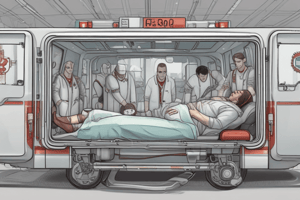Podcast
Questions and Answers
It is recommended to push the bone ends back in when dealing with an injury.
It is recommended to push the bone ends back in when dealing with an injury.
False (B)
When medical help is on the way and arriving soon, it is important to immobilize the injury.
When medical help is on the way and arriving soon, it is important to immobilize the injury.
False (B)
Immobilizing the injury is necessary if medical help will be delayed or if the casualty needs to be transported.
Immobilizing the injury is necessary if medical help will be delayed or if the casualty needs to be transported.
True (A)
Applying heat to the injury is recommended.
Applying heat to the injury is recommended.
RICE stands for Rest, Immobilize, Cold, Elevate, and should be used for injuries to bones, joints, and muscles.
RICE stands for Rest, Immobilize, Cold, Elevate, and should be used for injuries to bones, joints, and muscles.
Even minor injuries do not benefit from RICE treatment.
Even minor injuries do not benefit from RICE treatment.
To secure a splint, you should use a roller bandage.
To secure a splint, you should use a roller bandage.
The position of function for an injured hand is palm up with fingers extended.
The position of function for an injured hand is palm up with fingers extended.
When immobilizing an injured finger or thumb, it is important to always flatten the hand against a flat surface first.
When immobilizing an injured finger or thumb, it is important to always flatten the hand against a flat surface first.
In case of a fractured upper leg (femur), internal bleeding can occur and lead to severe shock.
In case of a fractured upper leg (femur), internal bleeding can occur and lead to severe shock.
When immobilizing an injured upper leg (femur), it is important to break at the neck of the femur for proper support.
When immobilizing an injured upper leg (femur), it is important to break at the neck of the femur for proper support.
Using padding to provide extra support is not necessary when immobilizing an injured finger or thumb.
Using padding to provide extra support is not necessary when immobilizing an injured finger or thumb.
Bandage dressings should be applied loosely to prevent arm movement.
Bandage dressings should be applied loosely to prevent arm movement.
An arm sling should be used for an injured elbow to restrict movement.
An arm sling should be used for an injured elbow to restrict movement.
If the elbow is bent and the arm is in front of the chest, the arm should be immobilized in an arm sling.
If the elbow is bent and the arm is in front of the chest, the arm should be immobilized in an arm sling.
If circulation is impaired below the injury, it is not necessary to seek immediate medical help.
If circulation is impaired below the injury, it is not necessary to seek immediate medical help.
When immobilizing the forearm and wrist, the splint should be measured against the injured arm first.
When immobilizing the forearm and wrist, the splint should be measured against the injured arm first.
Padding under the elbow should be avoided when immobilizing the arm to allow more movement.
Padding under the elbow should be avoided when immobilizing the arm to allow more movement.
It is easy to fracture the upper leg in a younger, healthy person.
It is easy to fracture the upper leg in a younger, healthy person.
When using a long and a short splint, bandages should be placed at the elbows and wrists.
When using a long and a short splint, bandages should be placed at the elbows and wrists.
Bandages should be tied from ankle to chest when splinting an injury.
Bandages should be tied from ankle to chest when splinting an injury.
It is recommended to try straightening a leg if the pain increases or the leg does not move easily.
It is recommended to try straightening a leg if the pain increases or the leg does not move easily.
Splints should be placed just below the armpit and just above the groin when immobilizing an injured knee.
Splints should be placed just below the armpit and just above the groin when immobilizing an injured knee.
If the leg won't straighten easily or without increased pain, splint in a different position than found.
If the leg won't straighten easily or without increased pain, splint in a different position than found.
It is recommended to remove the shoe when providing first aid for an open fracture wound.
It is recommended to remove the shoe when providing first aid for an open fracture wound.
The dressing for an open fracture wound should cover the wound with a margin extending just to the edges of the wound.
The dressing for an open fracture wound should cover the wound with a margin extending just to the edges of the wound.
The padding for an open fracture should be placed crosswise on both sides of the fracture.
The padding for an open fracture should be placed crosswise on both sides of the fracture.
When tying a bandage over the padding and dressing, it should be tight enough to cut off circulation.
When tying a bandage over the padding and dressing, it should be tight enough to cut off circulation.
It is important to check circulation below the injury before tying all knots on the splint.
It is important to check circulation below the injury before tying all knots on the splint.
If splints are not available, it is acceptable to use the injured leg as an anatomical splint by tying the legs together.
If splints are not available, it is acceptable to use the injured leg as an anatomical splint by tying the legs together.
It is recommended to straighten a leg if the pain increases or the leg does not move easily.
It is recommended to straighten a leg if the pain increases or the leg does not move easily.
A roller bandage should be used to secure a splint.
A roller bandage should be used to secure a splint.
Applying heat to an injury is recommended.
Applying heat to an injury is recommended.
An arm sling should be used for an injured elbow to restrict movement.
An arm sling should be used for an injured elbow to restrict movement.
RICE stands for Rest, Immobilize, Cold, Elevate, and should be used for injuries to bones, joints, and muscles.
RICE stands for Rest, Immobilize, Cold, Elevate, and should be used for injuries to bones, joints, and muscles.
If splints are not available, it is acceptable to use the injured leg as an anatomical splint by tying the legs together.
If splints are not available, it is acceptable to use the injured leg as an anatomical splint by tying the legs together.
When immobilizing a dislocated shoulder, if the arm will not bend, it is recommended to bandage the arm around the neck to prevent movement.
When immobilizing a dislocated shoulder, if the arm will not bend, it is recommended to bandage the arm around the neck to prevent movement.
To immobilize a dislocated joint, it is advised to transfer the weight of the arm to the other side using broad bandages.
To immobilize a dislocated joint, it is advised to transfer the weight of the arm to the other side using broad bandages.
If circulation becomes impaired after immobilizing an injury, it is recommended to tighten the bandages further for extra support.
If circulation becomes impaired after immobilizing an injury, it is recommended to tighten the bandages further for extra support.
When immobilizing an open fracture of the upper arm (humerus), it is crucial to check circulation before covering the wound with a sterile dressing.
When immobilizing an open fracture of the upper arm (humerus), it is crucial to check circulation before covering the wound with a sterile dressing.
When immobilizing an upper arm open fracture, padding should be placed crosswise on both sides of the fracture site for extra protection.
When immobilizing an upper arm open fracture, padding should be placed crosswise on both sides of the fracture site for extra protection.
To immobilize an injured finger or thumb, it is recommended to always keep the hand flattened against a flat surface first.
To immobilize an injured finger or thumb, it is recommended to always keep the hand flattened against a flat surface first.
The arm sling should be wrapped tightly above and below the fracture site to prevent arm movement.
The arm sling should be wrapped tightly above and below the fracture site to prevent arm movement.
When immobilizing an injured elbow, the arm should always be left loose at the elbow within the arm sling.
When immobilizing an injured elbow, the arm should always be left loose at the elbow within the arm sling.
If the elbow is bent with the arm in front of the chest, it is recommended to immobilize the arm using a roller bandage.
If the elbow is bent with the arm in front of the chest, it is recommended to immobilize the arm using a roller bandage.
It is necessary to check circulation below the injury before adjusting the sling and/or bandages if it was impaired.
It is necessary to check circulation below the injury before adjusting the sling and/or bandages if it was impaired.
When immobilizing the forearm and wrist, it is important to measure the splint against the uninjured arm for comparison.
When immobilizing the forearm and wrist, it is important to measure the splint against the uninjured arm for comparison.
Providing heat to an injury is recommended when immobilizing the forearm and wrist.
Providing heat to an injury is recommended when immobilizing the forearm and wrist.
When immobilizing an injured finger or thumb, it is important to keep the hand in the position of function.
When immobilizing an injured finger or thumb, it is important to keep the hand in the position of function.
Padding is not necessary when immobilizing an injured finger or thumb.
Padding is not necessary when immobilizing an injured finger or thumb.
For an injured upper leg (femur), internal bleeding can lead to severe shock.
For an injured upper leg (femur), internal bleeding can lead to severe shock.
To keep an injured upper leg (femur) immobilized, a common fracture occurs at the neck of the femur.
To keep an injured upper leg (femur) immobilized, a common fracture occurs at the neck of the femur.
When immobilizing an injured finger, it's recommended to use a splint. If a splint is not available, secure the injured finger to the uninjured one.
When immobilizing an injured finger, it's recommended to use a splint. If a splint is not available, secure the injured finger to the uninjured one.
It's important to flatten a hand against a flat surface before immobilizing an injured finger or thumb.
It's important to flatten a hand against a flat surface before immobilizing an injured finger or thumb.
If the leg is straight, five broad bandages are positioned under the leg for splinting.
If the leg is straight, five broad bandages are positioned under the leg for splinting.
Bandaging over the padding and dressing should be tight enough to cut off circulation.
Bandaging over the padding and dressing should be tight enough to cut off circulation.
It is acceptable to use the injured leg as an anatomical splint by tying the legs together if no splints are available.
It is acceptable to use the injured leg as an anatomical splint by tying the legs together if no splints are available.
When dealing with an open fracture, apply pressure directly on the fracture site to stop bleeding.
When dealing with an open fracture, apply pressure directly on the fracture site to stop bleeding.
An open fracture occurs when the skin is broken, allowing the bone to stick out.
An open fracture occurs when the skin is broken, allowing the bone to stick out.
To immobilize a closed fracture of the lower leg, dressings and bandages should be applied over the wound.
To immobilize a closed fracture of the lower leg, dressings and bandages should be applied over the wound.
Flashcards are hidden until you start studying
Study Notes
Immobilization and Care for Injuries
- Steady and support the injured part, maintaining support until medical help takes over or the injury is immobilized.
- Protect protruding bones, but do not push the bone ends back in or attempt to apply traction to a limb.
- Consider factors such as other risks to the casualty, risks to yourself or others, and the time it takes for medical help to arrive when deciding whether to immobilize the injury.
RICE Method
- RICE stands for Rest, Immobilize, Cold, and Elevate.
- Most injuries to bones, joints, and muscles benefit from RICE.
- Rest means stopping the activity that caused the injury and staying off it until a doctor advises otherwise.
- Immobilize the injury to prevent further movement.
- Apply cold to the injury as appropriate.
- Elevate the injured area to reduce swelling.
Immobilizing Different Injuries
- For an injured arm:
- Immobilize the arm in the position of comfort, usually the position found.
- Use a sling to provide full support for the arm.
- Pad under the elbow as needed to hold the arm in the most comfortable position.
- For an injured elbow:
- Immobilize the injury in the position found, if possible, or in the position of greatest comfort.
- Expose the injury and look for any open wounds.
- Check circulation below the injury and compare it with the other side.
- For an injured forearm and wrist:
- Examine the injury and decide the best position for splinting, usually in the position found.
- Use a board or other rigid material as a splint, padding to keep the hand in the position of function.
- Secure the splint with a roller bandage, leaving fingertips visible to check for circulation.
Fractured Upper Leg (Femur)
- Signs and symptoms: pain, possibly severe; foot and leg may roll outward; deformity and shortening of the leg.
- Possible complications: internal bleeding, causing severe shock.
- Immobilizing an injured upper leg:
- A common fracture of the upper leg is a break at the neck of the femur.
- If the leg is straight, expose and assess the injury, and use a padded splint.
- If the leg is bent, position five broad bandages under the leg, two above the knee and three below, and secure the splint with the bandages.
Studying That Suits You
Use AI to generate personalized quizzes and flashcards to suit your learning preferences.




